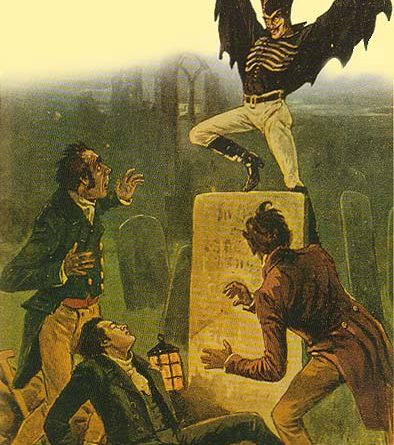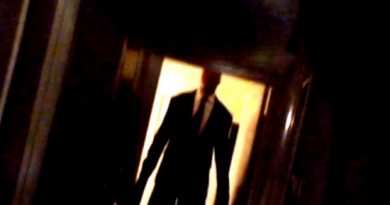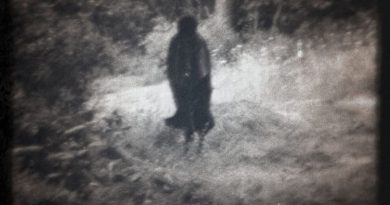Case of Spring Heeled Jack aka AlderShot Ghost
Spring Heeled Jack (also Springheel Jack, Spring-heel Jack, etc), is a character from English folklore said to have existed during the Victorian era and able to jump extraordinarily high. The first claimed sighting of Spring Heeled Jack that is known occurred in 1837. Later alleged sightings were reported all over England, from London up to Sheffield and Liverpool, but they were especially prevalent in suburban London and later in the Midlands and Scotland.
Many theories have been proposed to ascertain the nature and identity of Spring Heeled Jack. The urban legend of Spring Heeled Jack gained immense popularity in its time due to the tales of his bizarre appearance and ability to make extraordinary leaps, to the point where he became the topic of several works of fiction.
Spring Heeled Jack was described by people claiming to have seen him as having a terrifying and frightful appearance, with diabolical physiognomy that included clawed hands and eyes that “resembled red balls of fire”. One report claimed that, beneath a black cloak, he wore a helmet and a tight-fitting white garment like an “oilskin”. Many stories also mention a “Devil-like” aspect. Spring Heeled Jack was said to be tall and thin, with the appearance of a gentleman, and capable of making great leaps. Several reports mention that he could breathe out blue and white flames and that he wore sharp metallic claws at his fingertips. At least two people claimed that he was able to speak comprehensible English.
Jumping Jack’s Background
Victorian England houses many different strange events, but perhaps the most puzzling are those involving Springheel Jack. Jack’s strange appearance and superhuman abilities lead investigator’s to believe he is more then a mere man. Jack first appeared in September 1837 in London, England when he attacked three women in the dark of the night. One of the victims, Polly Adams, reportably had her clothes torn off which allowed Jack to scratch at her stomach with his iron clad fingers. The victims later described Jack as a tall, thin and powerful man who wore a dark cloak, glowing eyes and the ability to spit blue flames.
Attacks continued and London’s Lord Mayor, Sir John Cowan, declared Springheel Jack a menace in January 1838. A vigilante group soon formed to capture Jack, but he was able to escape all attempts.
Perhaps the most infamous attack occurred on February 20, 1838 in London. Late that night, a strange figure stood at the gate of a home and yelled out, “For God’s sake, bring me a light, for we have caught Springheel Jack in the lane!” Within moments, eighteen year old Jane Alsop ran outside with a candle and confronted the figure. Alsop claimed the figure was enveloped in a large cloak and spit blue and white flames. The figure grabbed the young girl and clawed at her dress with his sharp fingers. Aslop’s sister ran to her aid and dragged her inside the house. Strangely, the attacker knocked on the door several times and waited for a response before he finally left after the sisters called for help. During his escape, Jack dropped his cloak which was quickly picked up by an apparent accomplice of his.
Yet another attack took place on February 28 when Miss Lucy Scales was attacked at about 8:30 PM while traveling through an alley. She was attacked in much the same way as the previous victims, but her attack left her with seizure-like fits. Surgeon Charles Pritchel later told authorities that she “was suffering from hysterics and great agitation, in all probability the result of fright.”
Early reports
The first accounts of Spring Heeled Jack were made in London in 1837 and the last reported sighting is said in most of the secondary literature to have been made in Liverpool in 1904.
The first report of Jack was from a businessman returning home late one night from work, who told of being suddenly shocked as a mysterious figure jumped with ease over the high railings of a cemetery, landing right in his path. No attack was reported, but the submitted description was disturbing: a muscular man with devilish features including large and pointed ears and nose, and protruding, glowing eyes.
Later, in October 1837, a girl by the name of Mary Stevens was walking to Lavender Hill, where she was working as a servant, after visiting her parents in Battersea. On her way through Clapham Common, according to her later statements, a strange figure leapt at her from a dark alley. After immobilising her with a tight grip of his arms, he began to kiss her face, while ripping her clothes and touching her flesh with his claws, which were, according to her deposition, “cold and clammy as those of a corpse”. In panic, the girl screamed, making the attacker quickly flee from the scene. The commotion brought several residents who immediately launched a search for the aggressor, who could not be found.
The next day, the leaping character is said to have chosen a very different victim near Mary Stevens’ home, inaugurating a method that would reappear in later reports: he jumped in the way of a passing carriage, causing the coachman to lose control, crash, and severely injure himself. Several witnesses claimed that he escaped by jumping over a nine foot-high (2.7 m) wall while babbling with a high-pitched and ringing laughter.
Gradually, the news of the strange character spread, and soon the press and the public gave him a name: Spring-heeled Jack.
The Scales and Alsop reports
Perhaps the best known of the alleged incidents involving Spring Heeled Jack were the attacks on two teenage girls, Lucy Scales and Jane Alsop. The Alsop report was widely covered by the newspapers, including a piece in The Times, while a single paper covered the Scales report, presumably because Alsop came from a comfortably well-off family and Scales from a family of tradesmen[who?]. This coverage by newspapers fuelled the collective hysteria surrounding the case.
Alsop case
Jane Alsop reported that on the night of February 19 she answered the door of her father’s house to a man claiming to be a police officer, who told her to bring a light, claiming “we have caught Spring-heeled Jack here in the lane”. She brought the person a candle, and noticed that he wore a large cloak. The moment she had handed him the candle, however, he threw off the cloak and “presented a most hideous and frightful appearance”, vomiting blue and white flame from his mouth while his eyes resembled “red balls of fire”. Miss Alsop reported that he wore a large helmet and that his clothing, which appeared to be very tight-fitting, resembled white oilskin. Without saying a word he caught hold of her and began tearing her gown with his claws which she was certain were “of some metallic substance”. She screamed for help, and managed to get away from him and ran towards the house. He caught her on the steps and tore her neck and arms with his claws. She was rescued by one of her sisters, after which her assailant fled.
Scales case
Eight days after the attack on Miss Alsop, on February 28, 1838, 18-year-old Lucy Scales and her sister were returning home after visiting their brother, a butcher who lived in a respectable part of Limehouse. Miss Scales stated in her deposition to the police that as she and her sister were passing along Green Dragon Alley, they observed a person standing in an angle of the passage. She was walking in front of her sister at the time, and just as she came up to the person, who was wearing a large cloak, he spurted “a quantity of blue flame” in her face, which deprived her of her sight, and so alarmed her, that she instantly dropped to the ground, and was seized with violent fits which continued for several hours.
Her brother added that on the evening in question, he had heard the loud screams of one of his sisters moments after they had left his house and on running up Green Dragon Alley he found his sister Lucy on the ground in a fit, with her sister attempting to hold and support her. She was taken home, and he then learned from his other sister what had happened. She described Lucy’s assailant as being of tall, thin, and gentlemanly appearance, covered in a large cloak, and carrying a small lamp or bull’s eye lantern similar to those used by the police. The individual did not speak nor did he try to lay hands on them, but instead walked quickly away. Every effort was made by the police to discover the author of these and similar outrages, and several persons were questioned, but were set free
Aldershot
his news was followed by more reported sightings, until in August 1877 one of the most notable reports about Spring Heeled Jack came from a group of soldiers in Aldershot’s barracks. This story went as follows: a sentry on duty at the North Camp peered into the darkness, his attention attracted by a peculiar figure bounding across the road towards him, making a metallic noise. The soldier issued a challenge, which went unheeded, and the figure vanished from sight for a few moments. As the soldier turned back to his post, the figure reappeared beside him and delivered several slaps to his face with “a hand as cold as that of a corpse”. Attracted by the ensuing noise, several men rushed to the place, but they claimed that the character leapt several feet over their heads and landed behind them. One of the guards shot at him, with no visible effect other than to enrage his target; some sources claim that the soldier may have fired blanks at him, merely used to make warning shots. The strange figure then disappeared into the surrounding darkness.
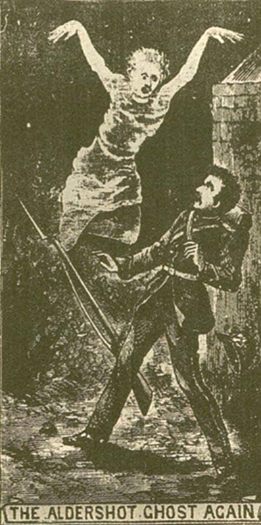
Theories
No one was ever caught and identified as Spring Heeled Jack; combined with the extraordinary abilities attributed to him and the very long period during which he was reportedly at large, this has led to all sorts of theories of his nature and identity. While several researchers seek a rational explanation for the events, other authors explore the more fantastic details of the story to propose different kinds of paranormal speculation.
Sceptical positions
Sceptical investigators have dismissed the stories of Spring Heeled Jack as mass hysteria which developed around various stories of a bogeyman or devil which have been around for centuries, or from exaggerated urban myths about a man who clambered over rooftops claiming that the Devil was chasing him
Other researchers believe that some individual(s) may have been behind its origins, being followed by imitators later on. Spring Heeled Jack was widely considered not to be a supernatural creature but rather one or more persons with a macabre sense of humour. This idea matches the contents of the letter to the Lord Mayor, which accused a group of young aristocrats as the culprits, after an irresponsible wager. A popular rumour circulating as early as 1840 pointed to an Irish nobleman, the Marquess of Waterford, as the main suspect. Haining suggested this may have been due to him having previously had bad experiences with women and police officers.
The Marquess was frequently in the news in the late 1830s for drunken brawling, brutal jokes and vandalism, and was said to do anything for a bet; his irregular behaviour and his contempt for women earned him the moniker “the Mad Marquis”, and it is also known that he was in the London area by the time the first incidents took place. But The Waterford Chronicle was able to report his presence at the St Valentine’s Day Ball at Waterford Castle, giving him an alibi for the reported attacks on Jane Alsop and Lucy Scales that are central to Jack’s alleged existence. Nevertheless, in 1880 he was named as the perpetrator by the Rev. E. C. Brewer, who attested that the Marquess “used to amuse himself by springing on travellers unawares, to frighten them, and from time to time others have followed his silly example”. In 1842, the Marquess of Waterford married and settled in Curraghmore House, Ireland, and reportedly led an exemplary life until he died in a riding accident in 1859. Spring Heeled Jack remained active for decades after, which leads the aforementioned modern researchers[who?] to the same conclusion as Brewer’s.
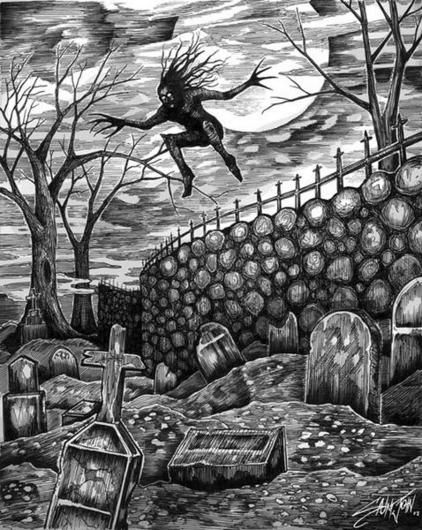
Paranormal conjectures
A variety of paranormal explanations have been proposed to explain the origin of Spring Heeled Jack, including that he was an extraterrestrial entity with a non-human appearance and features, (e.g., retro-reflective red eyes, or phosphorus breath) and a superhuman agility deriving from life on a high gravity world, jumping ability and strange behaviour[25] and that he was a demon, accidentally or purposefully summoned into this world by practitioners of the occult or who made himself manifest simply to create spiritual turmoil.
Discuss article
